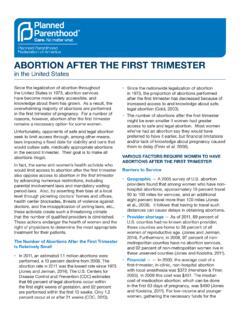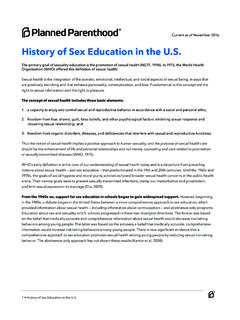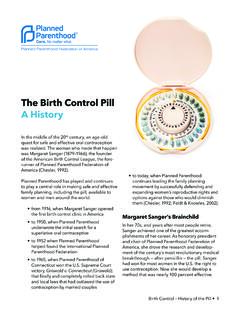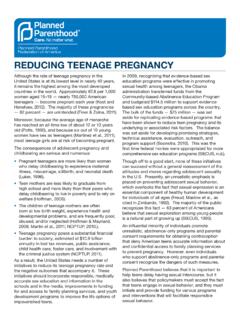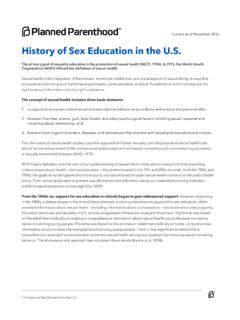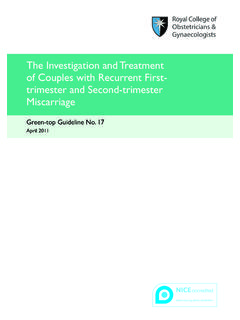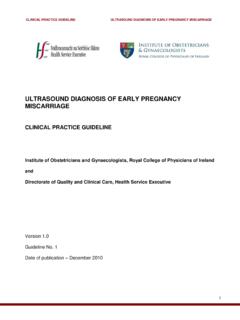Transcription of ROE V. WADE: ITS HISTORY AND IMPACT
1 Supreme Court Finds Right to Choose AbortionOn January 22, 1973, the Supreme Court announced its decision in Roe v. Wade, a challenge to a Texas statute that made it a crime to perform an abortion unless a woman s life was at stake. The case had been filed by Jane Roe, an unmarried woman who wanted to safely and legally end her pregnancy. Siding with Roe, the court struck down the Texas law. In its ruling, the court recognized for the first time that the constitutional right to privacy is broad enough to encompass a woman s decision whether or not to terminate her pregnancy (Roe v. Wade, 1973).Roe has come to be known as the case that legalized abortion nationwide. At the time the decision was handed down, nearly all states outlawed abortion except to save a woman s life or for limited reasons such as preserving the woman s health, or instances of rape, incest, or fetal anomaly.
2 Roe rendered these laws unconstitutional, making abortion services vastly safer and more accessible to women throughout the country. The decision also set a legal precedent that affected more than 30 subsequent Supreme Court cases involving restrictions on access to Reflects American Traditions, Changing TimesTo reach its decision in Roe, the Supreme Court drew on decades of case law that established that the government cannot interfere with certain personal decisions about procreation, marriage, and other aspects of family life. In Griswold v. Connecticut (1965), an appeal of the criminal conviction of the executive director of the Planned Parenthood League of Connecticut for providing contraceptives to married couples, the Supreme Court found that a state statute making it a crime to use birth control violated married couples right to privacy.
3 Seven years later, the justices found that this right also applied to single people (Eisenstadt v. Baird, 1972). Together, these cases set the stage for was also a reflection of the changing times. By the late 1960s, a nationwide effort was underway to reform the criminal abortion laws in effect in nearly every state. Health care providers, women s rights advocates, clergy members, and the legal community lobbied state legislatures and went to court to overturn statutes that had been in place since before the turn of the century. Many of these laws dated back to the mid-1800s, when state legislatures moved to ban abortion despite this nation s HISTORY since colonial times of allowing abortion prior to quickening. Between 1967 and 1973, four states Alaska, Hawaii, New York, and Washington repealed their abortion bans, while 13 others enacted limited reforms (Gold, 1990).
4 Even before Roe was decided, lawsuits challenging criminal abortion laws had begun to work their way through the courts in more than a dozen Constitutional Right Is DefinedIn Roe, the Supreme Court found that a woman s right to make her own decisions about her pregnancy deserves the highest level of constitutional protection. The court also recognized that the right to privacy is not absolute and that a state has valid interests in safeguarding maternal health and protecting potential life. A state may but is not required to prohibit abortion after viability, except when it is necessary to protect a woman s life or V. WADE: ITS HISTORY AND IMPACTThe Lives and Health of Women and Families ImproveIn 1965, abortion was so unsafe that 17 percent of all deaths due to pregnancy and childbirth were the result of illegal abortion (Gold, 1990; NCHS, 1967).
5 Today, less than percent of women undergoing legal abortions at all gestational ages sustain a serious complication requiring hospitalization (Boonstra et al., 2006; Henshaw, 1999). Among women undergoing legal first-trimester abortion procedures, the percentage sustaining serious complications drops to percent (Weitz et al., 2013). The risk of death associated with abortion increases with the length of pregnancy, from one death for every one million vacuum aspiration abortions at eight or fewer weeks to deaths after 20 weeks gestation (Boonstra et al., 2006). In 2007, the maternal mortality rate in the was deaths per 100,000 live births a significant difference in maternal mortality rates between ending a pregnancy by abortion and carrying it to term (Paul et al., 2009; Xu et al.)
6 , 2010). The risk of death from medication abortion through 63 days gestation is about one per 100,000 procedures (Grimes, 2005). In comparison, the risk of death from miscarriage is about one per 100,000 (Saraiya et al., 1999). And the risk of death associated with childbirth is about 14 times as high as that associated with abortion (Raymond & Grimes, 2012).The ability to make this personal health care decision has also enabled women to pursue educational and employment opportunities that were often unthinkable prior to Roe. The Supreme Court noted in 1992 that the ability of women to participate equally in the economic and social life of the Nation has been facilitated by their ability to control their reproductive lives (Planned Parenthood of Southeastern Pennsylvania v. Casey, 1992).
7 Justice Harry Blackmun, the author of Roe, called the decision a step that had to be taken as we go down the road toward the full emancipation of women (Greenhouse, 1994).Constant Attacks Undermine the Right to Choose AbortionImmediately after Roe was decided, opponents of safe and legal abortion urged state and federal lawmakers to pass laws stripping away at or banning abortion. Over the next three decades, the Supreme Court was repeatedly called upon to decide whether a wide range of abortion statutes violated a woman s right to privacy. While many of these restrictions were found unconstitutional, the court opened the door to limits on the ability of low-income women and young women to make the decision to end a pregnancy in a series of cases beginning in the mid-1970s. State and federal bans on funding for abortions were upheld as were requirements that young women obtain the consent of or notify their parents prior to an abortion.
8 Two examples of these restrictive decisions are Harris v. McRae (1980) and Hodgson v. Minnesota (1990).By 1992, changes in the makeup of the Supreme Court led many to believe that it might overturn Roe when it decided a challenge to several Pennsylvania abortion restrictions. However, in Planned Parenthood of Southeastern Pennsylvania v. Casey (1992), the court reaffirmed the core holding of Roe that the constitutionally protected right to privacy includes every woman s right to make her own personal medical decisions. Nevertheless, the court made it more difficult for women to succeed in challenging laws that were less than absolute prohibitions on abortion. The court ruled that in order to succeed in a constitutional challenge, a law must be shown to have the purpose or effect of placing a substantial obstacle in the path of a woman seeking an abortion.
9 Under this test many abortion restrictions have been upheld, including requirements that women make multiple trips to an abortion provider and suffer an enforced delay prior to obtaining an 2007, additional changes in the makeup of the court led to further restrictions on a woman s ability to make personal medical decisions about her pregnancy. Despite having struck down a similar law just seven years earlier (Stenberg v. Carhart (2000)), on April 18, 2007, in Gonzales v. Carhart and Gonzales v. Planned Parenthood Federation of America, Inc., the newly composed court, in a 5 4 decision, upheld the first federal legislation to criminalize abortion. This legislation, the so-called Partial-Birth Abortion Ban Act of 2003, which does not contain an exception for the woman s health, makes it a federal crime to take certain steps when performing a second -trimester abortion (Partial Birth Abortion Ban Act of 2003, 2003).
10 In upholding the ban, the court effectively overruled a key component of Roe that it had previously affirmed again and again that women s health must be the paramount concern in laws that restrict abortion access. Retreating from this core principle, the Supreme Court allowed Congress to ban certain second -trimester abortion procedures that doctors and major medical organizations, including the American College of Obstetricians and Gynecologists, believe are sometimes the safest and best to protect women s health. As Justice Ruth Bader Ginsburg explained in dissent in Carhart, while the court did not directly overrule any of its precedent, the decision is alarming because for the first time since Roe, the Court bless[ed] a prohibition with no exception safeguarding a woman s health. Moreover, in Carhart, the court took a very expansive approach toward the state interest that may justify abortion restrictions.
